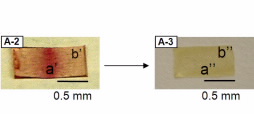EMBARGOED FOR RELEASE | March 26, 2012
New plastics “bleed” when cut or scratched — and then heal like human skin
Note to journalists: Please report that this research was presented at a meeting of the American Chemical Society
A press conference on this topic will be held at 1 p.m. Eastern Time, March 26, 2012, in the ACS Press Center, Room 15A, in the San Diego Convention Center. Reporters can attend in person or access live audio and video of the event and ask questions at www.ustream.tv/channel/acslive.
SAN DIEGO, March 26, 2012 — A new genre of plastics that mimic the human skin’s ability to heal scratches and cuts offers the promise of endowing cell phones, laptops, cars and other products with self-repairing surfaces, scientists reported today. The team’s lead researcher described the plastics, which change color to warn of wounds and heal themselves when exposed to light, here today at the 243rd National Meeting & Exposition of the American Chemical Society (ACS), the world’s largest scientific society.
Media Contact
During the meeting, March 23-28, the contacts can be reached at 619-525-6268.
Michael Bernstein
202-872-6042
m_bernstein@acs.org
Michael Woods
202-872-6293
m_woods@acs.org
“Mother Nature has endowed all kinds of biological systems with the ability to repair themselves,” explained Professor Marek W. Urban, Ph.D., who reported on the research. “Some we can see, like the skin healing and new bark forming in cuts on a tree trunk. Some are invisible, but help keep us alive and healthy, like the self-repair system that DNA uses to fix genetic damage to genes. Our new plastic tries to mimic nature, issuing a red signal when damaged and then renewing itself when exposed to visible light, temperature or pH changes.”
Urban, who is with the University of Southern Mississippi in Hattiesburg foresees a wide range of potential applications for plastic with warn-and-self-repair capabilities. Scratches in automobile fenders, for instance, might be repaired by simply exposing the fender to intense light. Critical structural parts in aircraft might warn of damage by turning red along cracks so that engineers could decide whether to shine the light and heal the damage or undertake a complete replacement of the component. And there could be a range of applications in battlefield weapons systems.
Plastics have become so common, replacing steel, aluminum, glass, paper and other traditional materials because they combine desirable properties such as strength, light weight and corrosion resistance. Hundreds of scientists around the world have been working, however, to remedy one of the downsides of these ubiquitous materials: Once many plastics get scratched or cracked, repairs can be difficult or impossible.
Self-healing plastics have become a Holy Grail of materials science. One approach to that goal involves seeding plastics with capsules that break open when cracked or scratched and release repairing compounds that heal scratches or cuts. Another is to make plastics that respond to an outside stimulus — like light, heat or a chemical agent — by repairing themselves.
Urban’s group developed plastics with small molecular links or “bridges” that span the long chains of chemicals that compose plastic. When plastic is scratched or cracked, these links break and change shape. Urban tweaked them so that changes in shape produce a visible color change — a red splotch that forms around the defect. In the presence of ordinary sunlight or visible light from a light bulb, pH changes or temperature, the bridges reform, healing the damage and erasing the red mark.
Urban cited other advantages of the new plastic. Unlike self-healing plastics that rely on embedded healing compounds that can self-repair only once, this plastic can heal itself over and over again. The material also is more environmentally friendly than many other plastics, with the process for producing the plastic water-based, rather than relying on potentially toxic ingredients. And his team now is working on incorporating the technology into plastics that can withstand high temperatures.
Urban acknowledged research funding from the U. S. Department of Defense.
To automatically receive news releases from the American Chemical Society contact newsroom@acs.org.
###

themselves when exposed to light.

